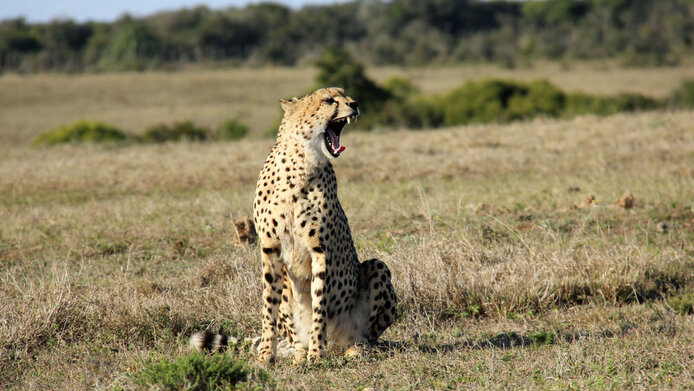Chirping cheetahs
Do cheetahs use birdsong-like sounds as a form of camouflage? It would make good sense to do so – after all, up to 70% of their cubs are killed by hyenas and lions.

The South African savannah is baking under the glaring sun. A breeze is wafting through the tall grass and the few shade-giving trees. There are birds zooming through the air, chirping loudly. But not everything is as it seems. In the midst of the familiar bird calls there hides a signal that belongs to a completely different animal, a much larger one – the cheetah.
This is more or less the scenery Angela Stöger encounters on one of her field research days. A biologist holding senior positions at the University of Vienna and the Austrian Academy of Sciences, Stöger has been researching, for more than a decade, the sounds mammals produce and how these sounds impact their behavior.
“I've always been interested in how mammals communicate,” Stöger recalls. After her studies at the University of Vienna, she acquired her doctorate on the topic of acoustic communication in elephants. Since then, Stöger and her team have been investigating how and why elephants produce sounds.
“Elephants can produce a great variety of sounds,” explains Stöger. “Anything from a high-pitched squeak to a deep rumble that extends into the infrasound level.” Infrasound refers to sounds that are too low for humans to hear. Elephants, however, are able to hear them and use them to communicate across long distances.
Stöger is investigating how exactly the elephants produce these sounds. “With an acoustic camera that can pinpoint the source of a sound using several microphones, we can see exactly where the sounds are produced. We have used it to show, for instance, how the animals press air between their lips or through their trunks to produce certain sounds.”
Not satisfied with merely finding out how the animals produce the sounds, the researchers also wanted to know how they react to their own “language”. For this purpose, Stöger and her team played their recordings to elephants in the wild. “We were able to show that elephants can imitate sounds they hear – that means they have the ability of vocal learning.” While we know vocal learning from small children who imitate words, this is an idiosyncrasy in the animal kingdom. The researchers even demonstrated that individual elephant groups use their own “dialects” and can thus recognize each other across long distances by means of infrasound.
Equipped with this wealth of knowledge and experience, Stöger and her team are now devoting their attention to another mammal, the cheetah, in their new FWF-funded research project.
“I already started looking into cheetahs twenty years ago,” says Stöger. “These animals produce many sounds to communicate with each other – including a high-pitched chirp that sounds just like the call of a bird. Even back then, I wondered why they do that.”
This chirping is the highest sound that cheetahs can make. A plausible explanation could be that they use it for camouflage so as not to attract attention and hide in the background noise of the savannah. While being formidable hunters, cheetahs have to be careful to avoid other predators. Up to 70 percent of cheetah cubs are killed by hyenas and lions. “When I play these calls to my colleagues in behavioral biology, even they can hardly distinguish them from bird calls,” Stöger adds with a smile.
“In spring 2024, we will make a research trip to the Kalahari Desert in order to investigate over what distances these calls can be heard in the local environment and to test their effect on other animals,” Stöger reports. In order to gain a more in-depth understanding of the cheetah sounds, the researchers will play them at different times of day and under different weather conditions, and measure the distances over which they can still be heard. They also want to find out whether lions and antelopes recognize these sounds and react to them. Their findings would not only deepen our understanding of these big cats, but could also help national parks and zoos to breed cheetahs, since they are now considered an endangered species. Stöger adds: “I'm really looking forward to the next field trip. Seeing animals in the wild is always a very special experience.”
Personal details
Angela Stöger acquired her venia docendi in behavioral and cognitive biology at the University of Vienna. She heads the Mammal Communication Lab, which is supported by the Austrian Science Fund FWF and has recently been established at the Acoustics Research Institute of the Austrian Academy of Sciences (ÖAW). She is also part of the FWF-funded doctoral program “Communication and Cognition” at the University of Vienna and the University of Veterinary Medicine Vienna. In 2023, Stöger published the book Elefanten - Ihre Weisheit, ihre Sprache und ihr soziales Miteinander, which was shortlisted for the Science Book of the Year 2024 award.